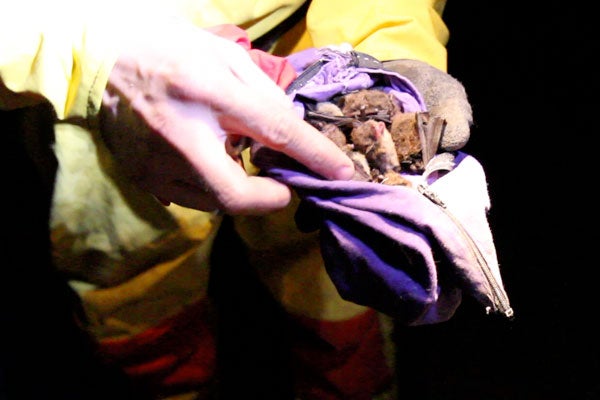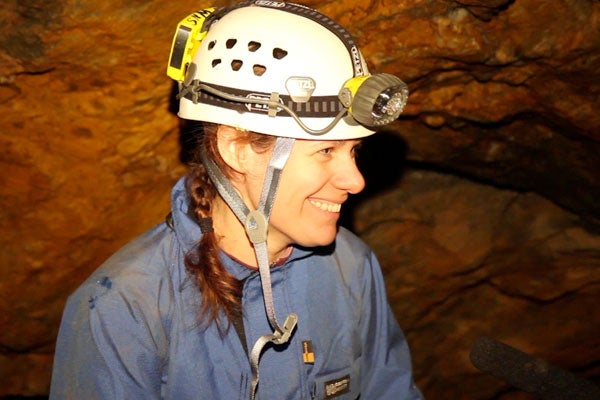Scientific community unites to save bats
Greg Turner is deep in an old mine near Allentown, Pennsylvania, wearing a yellow protective jumpsuit and a miner’s lamp on his head. He is standing in a large chamber where the mine’s floor slopes to meet the ceiling, an arm stretched high above his head.
“We need to collect these now, before they start flying,” he whispers. “Once they wake up and start flying around we’ll not be able to get our hands on them again.”
He is plucking little brown bats from their perches on the ceiling and dropping them into cloth bags, which he tucks into his own suit to keep them warm. Turner, a specialist on endangered mammals with the Pennsylvania Game Commission, says when he was in this mine last year there were swaths 5 feet long of bats in this chamber. Now, he sees clumps of two to three, maybe a dozen here or there.
“Before white nose this was one of the main concentration areas, and there would be about 2,000 bats in this room,” Turner says. Now he estimates that he sees a few hundred.
 White nose syndrome was first discovered in New York State in the winter of 2006-2007. Since then it has caused the deaths of well over a million bats in the Eastern United States. It killed 95 percent of bats in some affected caves in Eastern Pennsylvania last winter, and scientists expect it to do the same in the western part of the state this year.
White nose syndrome was first discovered in New York State in the winter of 2006-2007. Since then it has caused the deaths of well over a million bats in the Eastern United States. It killed 95 percent of bats in some affected caves in Eastern Pennsylvania last winter, and scientists expect it to do the same in the western part of the state this year.
Pennsylvania is at the center of white nose research this winter. Most of the state’s bats are likely affected. But, unlike in some other states farther east, some are still alive. Scientists are scrambling this winter to find out what is causing the fungus and what, if anything, they can do to stop it.
Scientists struggling with unknowns
White nose syndrome got its name from the fungus associated with the die-off. It causes a white fuzz to grow on the ears, noses and wings of cave-hibernating bat species. Scientists don’t know where the fungus comes from, but they guess it may have been transplanted from Europe and has been passed from bat to bat since.
Scientists still don’t know exactly how the fungus kills bats. They hypothesize it somehow arouses bats more often than normal during hibernation. That means they have to raise their body temperatures from ambient temperature, around 40 or 50 degrees, to nearly 100 degrees more times during the winter. That uses up a lot of energy and depletes fat stores, according to Hazel Barton, a cave microbiologist from Northern Kentucky University who is doing research in the mine.
“If you have a bat that keeps getting woken up by this fungus it’s going to use up those fat reserves and it’s going to be starving before spring comes and the insects are around,” Barton said.
 But, like much of what is suspected about the fungus, this is still just a hypothesis. Barton is in the mine with Turner, conducting experiments into what she calls a “Band-Aid” – a treatment for white nose syndrome. With 2-by-4’s and wire mesh, she’s building wooden cages where she’ll place the bats to hibernate for the winter. Under each cage is a bottle of a different type of compound that laboratory tests have shown to stop the growth of the white nose fungus. The compounds will evaporate onto the bats, resting above, and, Barton hopes, keep them alive.
But, like much of what is suspected about the fungus, this is still just a hypothesis. Barton is in the mine with Turner, conducting experiments into what she calls a “Band-Aid” – a treatment for white nose syndrome. With 2-by-4’s and wire mesh, she’s building wooden cages where she’ll place the bats to hibernate for the winter. Under each cage is a bottle of a different type of compound that laboratory tests have shown to stop the growth of the white nose fungus. The compounds will evaporate onto the bats, resting above, and, Barton hopes, keep them alive.
“We’ll know in April when we come to back to look at these cages,” Barton said. “If they’re all lying on the ground then it didn’t protect them. And if they’re all hanging on to the edge of the cage, then they’ve been protected.”
If it works, Barton hopes the compound can be used as a targeted treatment for at-risk bats next year, especially in caves that house endangered species.
Scientific community unites in quest for answers
Barton’s is just one of many theories the scientific community is testing this winter in a nationwide race to prevent extinction among some cave-hibernating bat species. Somre of the bats Greg Turner collected earlier will go into Barton’s test cages. But some will travel the hundred or so miles to Bucknell University, and one of the country’s centers of white nose research: the labs of DeeAnn Reeder. Reeder was the first to discover white nose in Pennsylvania, and now the biologist is running a dozen or so experiments trying to determine exactly what the connection is between this white fuzz and massive deaths.
Reeder says a few years ago, collaborations like the ones she’s formed with Barton and Turner didn’t really exist.
“To a certain degree we’ve had a paradigm shift in the way that many of us work,” Reeder said. “We typically hold our results pretty close to us, but really this has opened up new up new collaborations and data sharing because we just don’t have a choice. This is how we need to operate when stakes are so high.”
The ecosystemwide effects of the massive bat die-offs are hard to predict, but Reeder guesses they might be significant. Bats eat an enormous amount of insects every night. A female big brown bat, for example, when nursing her pups, will eat 110 percent of her body weight in insects every night.
“That’s like be eating 500 quarter-pounders every night,” Reeder says.
Fewer bats would mean more insects, including mosquitoes, which spread diseases like West Nile, and moths, which are crop pests.
More info on white-nose syndrome: PA Game Commission US Fish Wildlife Service USGS Professor finds white-nose syndrome in Pa. bats
Past stories: Fungus continues to kill off bats on the East coast White nose syndrome may be spreading to DE bats People could spread white nose syndrome Mysterious disease kills PA bats
It’s too soon to tell what the long-term effects on the ecosystem might be, but all hands are on deck in certain circles in an attempt to cut losses. State and federal agencies now coordinate trips into mines and caves by different researchers, to limit disruption to bats. And many caves and mines where bats hibernate, called hibernacula, have been closed down to hikers in an effort to reduce the risk of spreading the fungus to healthy populations.
Still, the fungus is spreading much faster than the scientific community thought it would. And now that a species of bat has been affected that has longer–distance migration patterns than the other bats, Reeder says it’s just going to move faster. That means long nights for the biologist, who uses an Excel spreadsheet just to keep track of all the studies she, a lab technician, two graduate student assistants and a slew of undergraduates are running in her lab.
“It is absolutely a race against time,” Reeder said. “My biggest fear is that basically we’re just documenting an extinction.”
The work is sometimes depressing, like when she walked into a field site last year that she’d been going to for years and had the realization that most of the bats would be dead by spring.
“To walk into a cave in January and see 80 percent of the bats covered in fungus and know that they’re going to die, is really depressing,” Reeder said. “What I chose to do with those emotions is to put my nose to the grindstone. The only thing I know is how to do my science.”
Reeder said she’s not working for the bats in Pennsylvania anymore. It’s too late to save them – she guesses that up to 90 percent of bats in affected caves will be dead by the spring. Now, she’s working to make the discoveries that will save bats on the West Coast, because that’s all she can do.
Want to see and hear more? Friend our Health+Science and Newsworks facebook pages for extra video and audio from this story later today.
WHYY is your source for fact-based, in-depth journalism and information. As a nonprofit organization, we rely on financial support from readers like you. Please give today.

